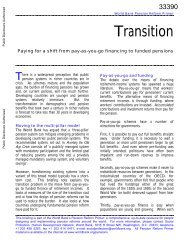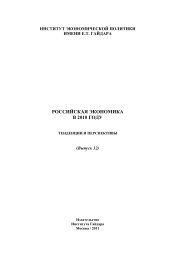Financial Sector Development in Africa: Opportunities ... - World Bank
Financial Sector Development in Africa: Opportunities ... - World Bank
Financial Sector Development in Africa: Opportunities ... - World Bank
Create successful ePaper yourself
Turn your PDF publications into a flip-book with our unique Google optimized e-Paper software.
Hous<strong>in</strong>g F<strong>in</strong>ance 117<br />
• The hous<strong>in</strong>g multiplier effect. This is a central argument <strong>in</strong> favor of hous<strong>in</strong>g<br />
<strong>in</strong>vestment. The premise is that every unit spent on hous<strong>in</strong>g will generate<br />
a multiple benefit for the economy, as it creates jobs through both<br />
horizontal and vertical supply cha<strong>in</strong>s. This <strong>in</strong>cludes jobs <strong>in</strong> areas such as<br />
raw material production, m<strong>in</strong><strong>in</strong>g, cement production, timber, and aggregates.<br />
In addition, there are also impacts on local economies where the<br />
construction jobs are created, and <strong>in</strong> the service <strong>in</strong>dustries l<strong>in</strong>ked to<br />
hous<strong>in</strong>g—such as mortgage lend<strong>in</strong>g, real estate agents, and retailers of<br />
home goods such as furniture or white goods. Although this argument is<br />
used regularly, there is no clear methodology or agreement on how to<br />
calculate the multiplier effect. There are several country studies that<br />
look at this effect, some of which are listed below. However, unfortunately,<br />
very few have looked at the multiplier effect <strong>in</strong> emerg<strong>in</strong>g markets.<br />
• United States. The multiplier effect accounts for the fact that <strong>in</strong>come<br />
earned <strong>in</strong> other sectors of the economy as a result of a home sale is<br />
then recirculated <strong>in</strong>to the economy. The National Association of<br />
Realtors’ macroeconomic model<strong>in</strong>g suggests that the multiplier is<br />
between 1.34 and 1.62 <strong>in</strong> the first year or two after an autonomous<br />
<strong>in</strong>crease <strong>in</strong> spend<strong>in</strong>g. This means that each dollar <strong>in</strong>crease <strong>in</strong> direct<br />
hous<strong>in</strong>g activity will <strong>in</strong>crease the overall GDP by $1.34 to $1.62.<br />
• Argent<strong>in</strong>a. A 2006 study found that just on the production side of<br />
raw materials and direct <strong>in</strong>puts for hous<strong>in</strong>g there was a 1.6 multiplier<br />
effect. Further <strong>in</strong>direct employment effects are also present <strong>in</strong><br />
related <strong>in</strong>dustries (see Duebel 2007).<br />
• Australia. The total multiplier for output and employment <strong>in</strong> the<br />
construction <strong>in</strong>dustry is estimated by the Australian Bureau of<br />
Statistics to be 2.866. So, for every $A 1 million <strong>in</strong>crease <strong>in</strong> construction<br />
output, there is an <strong>in</strong>crease <strong>in</strong> output elsewhere <strong>in</strong> the economy<br />
of $A 2.9 million (Duebel 2007).<br />
• Scotland. Some of the most detailed work has been done look<strong>in</strong>g at<br />
multiplier effects for Scotland (Whitehead and Monk 2010). Whitehead<br />
and Monk’s results show that the gross value added to the<br />
economy through different multiplier effects and channels <strong>in</strong> hous<strong>in</strong>g<br />
is higher than all other <strong>in</strong>dustries. Hous<strong>in</strong>g exhibits roughly a<br />
twofold multiplier effect <strong>in</strong> Scotland, so for every British pound<br />
(GBP) spent on hous<strong>in</strong>g, GBP 2 are generated for the economy.







